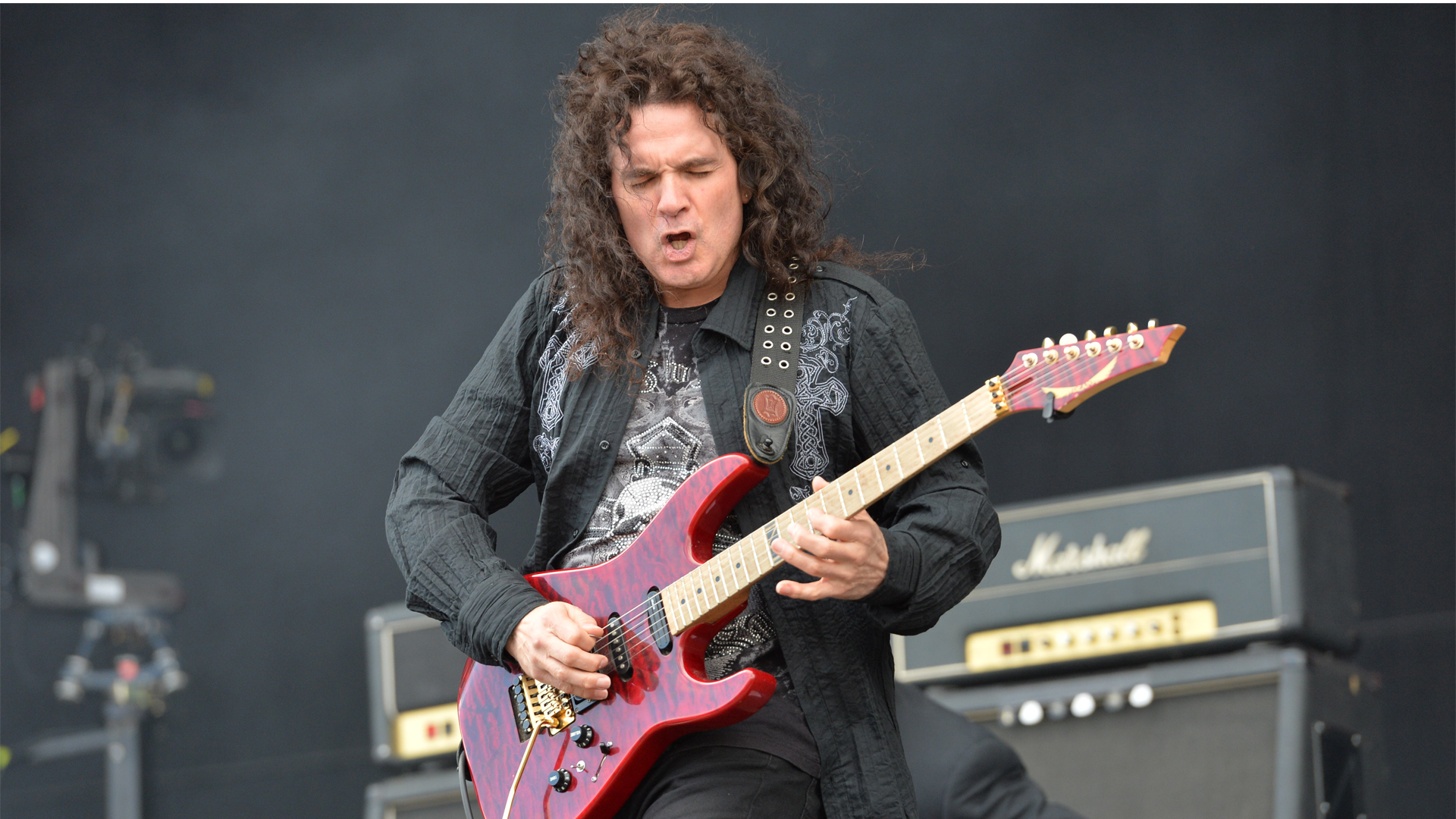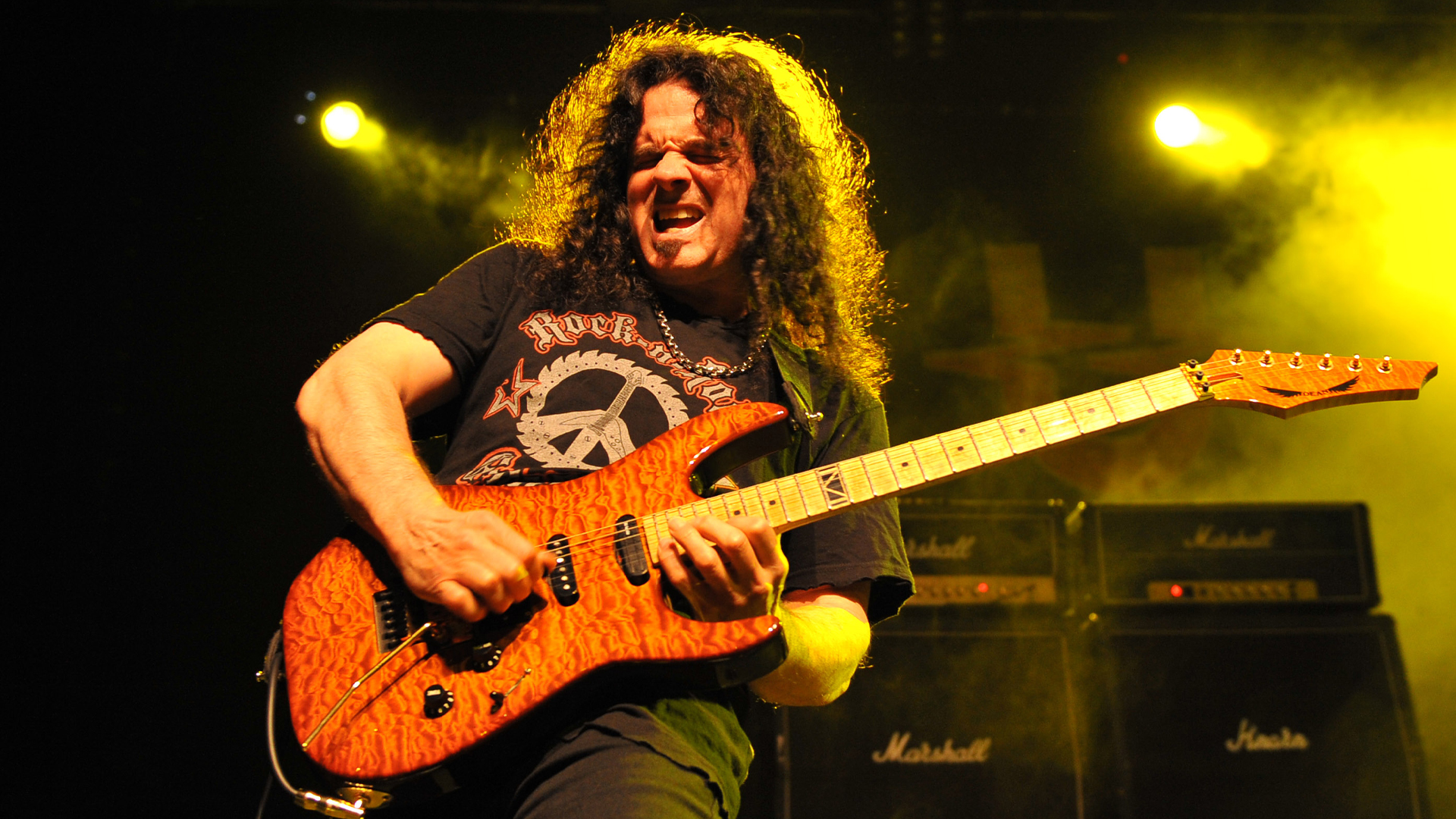
Back in the day, Vinnie Moore was a self-described “Eddie Van Halen freak.” He dedicated himself to learning every Van Halen lick and solo, and he threw them into everything he played. Then one night, while performing with a cover band, he realized that he had painted himself into a corner.
“Whatever song we played — it could be something by John Mellencamp or whoever — I would always toss in a fair share of Van Halen bits,” he remembers. “After one of our sets, I was in a men’s room stall, and I heard a customer say, ‘The band’s pretty good, but the guitarist has a hard time not playing Van Halen.’ I was like, ‘Wow, he’s right. I need to let go of that.’”
Moore — who has made the Kramer Pacer his main electric guitar as of late — quickly began to incorporate the influence of other guitarists in his playing. More importantly, he sought to develop his own identity. “I realized that any player I admired made his mark by being himself,” he says. “Players like Larry Carlton and Al Di Meola — they had their own thing going on. I had to do the same; otherwise I was just going to be a copycat.”
That’s one solid tip down. The guitar virtuoso has five more choice pieces of advice below — including one about metronomes that just might blow your mind.
When it comes soloing, Vinnie suggests guitarists start by taking inspiration from solos and melodies played on instruments other than guitar.
“Early on, I had become good at working out other players’ guitar solos note for note,” he explains. “But after a while it felt too easy. I started to notice similar phrases in what most of the guitarists were playing, and they started to sound like clichés.
“Then I tried to learn a keyboard solo. It was played very slowly, and I thought it would be a breeze. How wrong I was! Because it was played on an instrument other than guitar, the note choices went to places I didn’t expect.
All the latest guitar news, interviews, lessons, reviews, deals and more, direct to your inbox!
“It really opened my eyes. After that, I spent a lot of time learning solos and melodies that were played on other instruments. I especially liked learning saxophone solos. Very soon, I was expanding my library of licks, and after a while it made playing the guitar itself easier. I advise other guitarists to do the same. Listening to other instruments sends you to new places and away from all the licks and phrases that you probably play automatically.”
"Very soon, I was expanding my library of licks, and after a while it made playing the guitar itself easier."
—Vinnie Moore
And while you’re at it, be careful not to use all your hottest licks in a solo.
“When I was younger, I wanted to show the world what I could do,” he says. “But very soon I realized I had fallen into the ‘guitar clinic trap.’ My solos sounded like demonstrations of ability, but they didn’t sound like music.
As he explains, “a good solo should be something people can sing. All the shred stuff in the world flies right by them; it starts to sound like noise, not music. Eddie Van Halen played a lot of wild stuff that dazzled guitarists, but a lot of his solos are based around simple lines and melodies. He established a theme that you could grab on to, and then he threw in the crazy stuff. On the opposite end of the spectrum, there was Kurt Cobain. Now, he wasn’t a player in the Van Halen mold, but every time he played a solo, it was simple and direct, and you could sing it.
Whatever style of music you play, Vinnie cautions guitarists not to lose the groove when they take the lead.
“A lot of guitarists can play a great rhythm part, but they lose the groove the minute they go into a solo,” he says. “It’s like they’re just throwing in licks here and there, but they’re not part of the music.
“A player like Stevie Ray Vaughan was a master of both aspects of playing. When he played a solo, it’s as if he was playing rhythm at the same time. Hearing him got me thinking about how I soloed. I realized that I needed to keep in mind what the rhythm section was doing.”
To do that, Vinnie began moving his body to the music. “I started to tap my foot, move my head or sway my body to the rhythm,” he explains. “I guess you could say I was trying to be ‘at one’ with the rhythm.
“Try to think about rhythm while you’re soloing. Pretty soon, it will feel very natural, and you won’t have to think about it at all. And you won’t lose the groove because you’ll be working with it.”

To that end, Vinnie offers a tip that runs counter to just about everything you’ve heard before: Don’t play to a metronome.
“I’m going against the grain with this one," he says, "but it continues the point I made earlier about not losing the groove. I’ve noticed that when I’ve played to a metronome, I start to sound stiff and sterile. I was concentrating way too much on the click. I was in time, but I didn’t have feel.
“A lot of drummers in the studio play to clicks, but a great drummer isn’t always going to be right on the beat all the time. He’ll be a little behind here or a little ahead here. That’s what makes him sound human. That’s what makes feel.
"Each time I learned a couple of new chords, it seemed to spark a new song or idea. The difference it made in my overall musicianship was remarkable."
—Vinnie Moore
Instead of a metronome, Vinnie has found a more rhythmically satisfying approach.
“I don’t play to a metronome anymore, but I will play to drum programs and loops,” he reveals. “By doing that, I’m playing to a human drummer or a rhythm with a human feel, rather than to a clinical, totally perfect click. With loops, I noticed that the snare is sometimes behind the click, and the kick drum might be off a little bit. It doesn’t lose the time per se — it just sounds real. By playing to loops and programs, my playing has a swagger and looseness that I like.
“Plus, I don’t get bored! I improvise and play music, and I can push the beat or lay back. The bottom line is, it’s way more fun.”
And here’s one last great tip for the road: Buy a chord book.
“When I started playing guitar at 13, my teacher taught me chords, but there were a lot of holes in my knowledge. Sometime in my 20s, I saw a chord book in a music store, and as I flipped through it I realized that there were so many chords I didn’t know. I bought the book and dove in. There were all of these new voicings that I hadn’t played before. It was almost infinite. And what was amazing was, each time I learned a couple of new chords, it seemed to spark a new song or idea. The difference it made in my overall musicianship was remarkable.
“So learn some new chords and see if they inspire you. Maybe you’ll throw a new one into a piece of music you already know by heart, or try a new voicing of a chord you use all the time. Or you might go into a solo based around some new chords. Once you get into the habit, you’ll find your horizons expanding.”

Joe is a freelance journalist who has, over the past few decades, interviewed hundreds of guitarists for Guitar World, Guitar Player, MusicRadar and Classic Rock. He is also a former editor of Guitar World, contributing writer for Guitar Aficionado and VP of A&R for Island Records. He’s an enthusiastic guitarist, but he’s nowhere near the likes of the people he interviews. Surprisingly, his skills are more suited to the drums. If you need a drummer for your Beatles tribute band, look him up.
